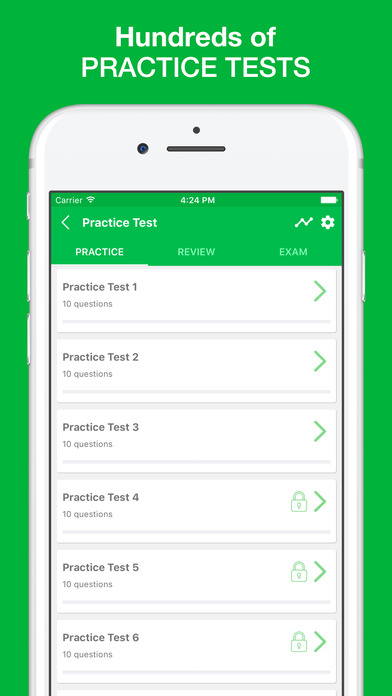
CBT Exam Questions 2017 Edition app for iPhone and iPad
Developer: Bua Nguyen
First release : 01 Jun 2017
App size: 53.2 Mb
PASS YOUR EXAM IN THE FIRST TRY WITH THE FOLLOWING REASONS:
+) BREAK hundreds of practice questions and flashcards INTO small sets
+) MASTER each study set effortlessly by many scientific proven methods: Multiple Choice, True/False, Matching, etc
+) TRACK your progress on every practice test and exam topic: MEASURE your weakest and strongest categories
+) SEPARATE hardest questions and cards into one group to study more effectively
+) CHALLENGE yourself by EXAM SIMULATOR with timebox and an intelligent grading system
Get the FREE app now to access:
+) Hundreds of free practice questions and flashcards
+) 5 Free Exam Builder with detailed explanation and history
+) Learn more efficiently with the Matching Game
Unlock the Premium Version to get access to:
*) ALL the Exam Questions
*) Hundreds of flashcards
*) Lifetime access to the Exam Builder
*) Lifetime support and updates
Cognitive behavioral therapy (CBT) is a form of psychotherapy. It was originally designed to treat depression, but is now used for a number of mental disorders.
It works to solve current problems and change unhelpful thinking and behavior.[1] The name refers to behavior therapy, cognitive therapy, and therapy based upon a combination of basic behavioral and cognitive principles.[1] Most therapists working with patients dealing with anxiety and depression use a blend of cognitive and behavioral therapy. This technique acknowledges that there may be behaviors that cannot be controlled through rational thought, but rather emerge based on prior conditioning from the environment and other external and/or internal stimuli. CBT is "problem-focused" (undertaken for specific problems) and "action-oriented" (therapist tries to assist the client in selecting specific strategies to help address those problems), or directive in its therapeutic approach. It is different from the more traditional, psychoanalytical approach, where therapists look for the unconscious meaning behind the behaviors and then diagnose the patient. Instead, behaviorists believe that disorders, such as depression, have to do with the relationship between a feared stimulus and an avoidance response, resulting in a conditioned fear, much like Ivan Pavlov. Cognitive therapists believed that conscious thoughts could influence a person’s behavior all on its own. Ultimately, the two theories were combined to create what is now known as cognitive behavioral therapy.
CBT is effective for a variety of conditions, including mood, anxiety, personality, eating, addiction, dependence, tic, and psychotic disorders. Many CBT treatment programs have been evaluated for symptom-based diagnoses and been favored over approaches such as psychodynamic treatments. However, other researchers have questioned the validity of such claims to superiority over other treatments. your knowledge, widen your expertise, improve your practice skills, Broaden your academic & career horizons.
Disclaimer:
This applications just is an excellent tool for self study and exam preparation. Its not affiliated with or endorsed by any testing organization, certificate, test name or trademark.



